.
The popularity of Greenland paddles has been growing rapidly. I no longer feel like being the "ugly duckling" when I meet other paddlers on the water and while there is still some disdain in certain circles the majority of the paddlers are accepting GPs as an alternative style to the high angle big blade Euro paddling.
But like all things that are different and don't conform to the status quo, they attract resistance by the old school masters. Ironically Greenland paddles are one of the oldest forms of paddles, it's just that modern materials have allowed for advancements in paddle design that led to short and wide blades that then became the norm and the old form was nearly forgotten (even tho short and wide was not unknown, just not as popular as in modern times).
The renessaince of the Greenland paddle would seem to be driven by nostalgia and would appeal to sea kayakers that work with timber and like to make their own equipment.
And that is true for the vast majority of the Greenland paddlers.
As Greenland paddles excel for rolling and plenty of paddlers practice the art of rolling with GPs, they are often also associated with paddling in calm conditions where an easy steady pace to cover distance is often sufficient and matches the speed of Euro paddling.
But things change when we talk about dynamic waters.
A lot of paddlers shake their heads when I suggest that the GP is a very useful and powerful paddle in the textured waters. Surely there is a difference between the skinny stick and the fat blade, is their argument.
Yes, there is an undeniable difference between the "big water" short blade of white water inspired sea kayak paddle and the distributed surface of a GP.
I would like to emphasize the "distributed"
A lot of Greenland paddles have a surface area that is similar to touring Euro paddles. Yep, if one measures the whole blade of the GP the numbers add up. If the GP is on the long side (230cm+)the surface area is actually surprising large and can exceed the widest Euro paddles, however I find no need to have an extra wide or long GP for playing in dynamic waters.
A typical cruising GP stroke is a low angle one where often just a portion of the blade is inserted into the water.
That is actually all is needed to cruise in a sea kayak: very little effort in propelling that hull in the water.
If one wants to then push the kayak and get close to hull speed more energy is required. While the common conception is that one has to paddle "faster" (higher cadence) to go faster with a GP I tend to change the angle of insertion of the blade into the water.
Once my stroke angle becomes higher I can deliver more blade into the water (more surface) and I have more resistance (less "slipping" back of the paddle) to apply more energy to my stroke. I can travel just as fast with a GP than with a EP.
So how does that translate to dynamic water paddling?
James Manke using a Greenland paddle (Northern Light) in all comditions
I use a higher angle when paddling in the surf zone, where I want a faster acceleration with my kayak; more blade enters the water allowing me to have more grunt.
Of course, water being a fluid substance, will flow around the skinny GP easier than a fat EP and while the difference is noticeable is not impossible to overcome. It is at this moment that I apply a higher cadence to achieve the desired initial propulsion in my kayak.
I think of it as driving a smaller engine car that is delivering the desired power by revving higher than a big block V8; the feel is different but the results similar.
So, in the surf zone where acceleration is really needed I have a higher angle and a higher cadence.
It is a short burst that is needed to get me gliding along with the energy of the wave.
The biggest benefit I find in a GP is the gentle support that it offers in a high brace.
As I surf along the wave I often broach, where my kayak is suddenly in line with the wave and getting pushed along sideways. If I don't want to get tipped I use a high brace to stabilize myself, like an outrigger.
As the waves can be occasionally powerful when I broach, the paddle in a high brace position tends to get elevated to the surface of the water. I feel that with a Greenland paddle that force is never as strong as with a wide bladed EP where a high position of my elbow could risk getting me a dislocated shoulder.
I seem to be able to contain that force and try to keep my arm in a much safer location.
Few can demonstrate the validity of the of the GP as an all rounder paddle better than Warren Williamson can in this video of extremely fast and turbulent waters of Deception Pass in WA, USA.
And while the current record of paddling around Vancouver Island is held by Joe O'Blenis with a Greenland paddle, we even have the Brits joining in the retro revolution with paddling around their big island .
.
26 June 2012
22 June 2012
VIDEO: having fun at dawn patrol
This guy knows how to have fun!
Embracing temperatures that I would consider rather cold for wet fun, Fat Paddler is happy to get out of bed when is still dark and line up at the beach for first light with his surfski.
I rarely have the opportunity to be on the water when the sun rises (OK it did happened once and it was just on freezing) but to then be chasing the “green room”?
Fat Paddler recommends full screen and full blast sound
I have never been know for raising early but given this prospect I could be talked into it :-)
Fat Paddler has been exploring the waterways of Sydney Harbour and beyond for the last couple of years.
He doesn't discriminate between canoes, sea kayaks, white water or skinny surfski: he loves it all.
Occasionally he even grabs a skinny paddle to mix it up.
Chasing no records and ruled by no governing body his love for the water is infectious.
More stories of his aquatic journeys at Fat Paddler website.
tags
bracing,
fun,
kayak surfing,
lightweight,
rough water,
sea kayak,
sunrise,
technique,
video
19 June 2012
REVIEW: Kokatat MsFit and OutFit life jackets
.
After 6 years of paddling with a Kokatat MsFit Tour it was time to look for a new life jacket (aka PFD).
The MsFit Tour served me well but there were just a few little things that slightly annoyed me.
Instead of replacing the MsFit with an updated version of the same I went for the OutFit Tour, the men's version.
So what's the difference/impovement between the two jackets?

The MsFit (yellow) is designed specifically for women even tho a lot of guys fit that PFD well.
The pocket arrangement is similar but the position of those is slightly different.
The OutFit locates the pockets more towards the centre of the chest while the MsFit has the pockets slightly more to the sides.

I find that the new OutFit clears my arms better than the MsFit for my relatively low stroke paddling.
The side pockets on the new OutFit have two zippered compartments and they are just big enough to carry my compact camera so it's always accessible while paddling.
On the MsFit the camera would occasionally interfere with my paddling.
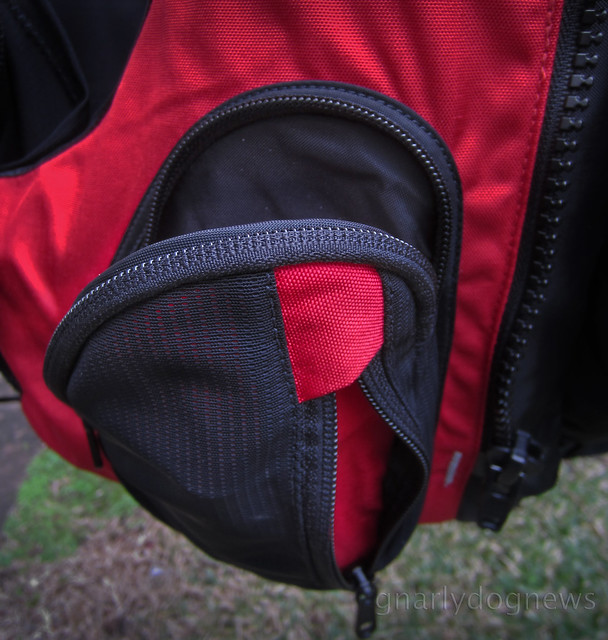
On the OutFit the pocket designed to house a VHF radio is now totally in the centre of the chest. I would not know if that is a better position since I don't carry a VHF there (not enough room to contain a dry-bagged radio).
Inside the front zippered opening there is a pocket for flares or a strobe light.

The shoulder straps have remained mainly unchanged and the heat moulded foam still pads the top excellently. The excess from the adjustment webbing is perfectly tucked into it's own sleeve and there is no annoying flapping of webbing hitting my face in a breeze.

There is no pocket on the back for a water bladder since Kokatat prefers to offer it as an add-on. I find carrying water on my shoulders a nuisance (and tiring) and I prefer to stow it below deck with a drinking hose.
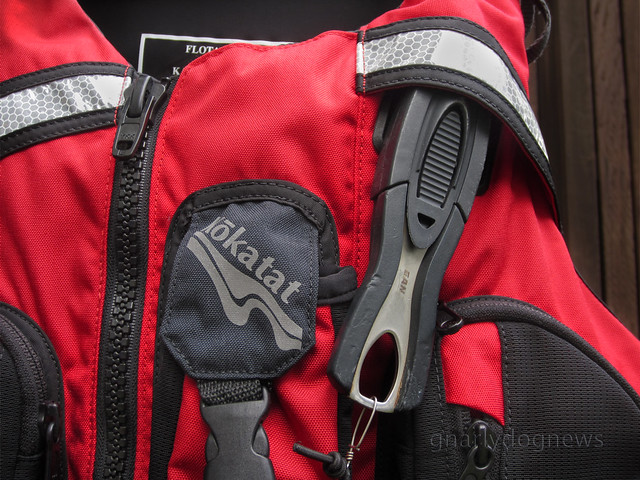
rescue knife lashing point has now a neat pocket to prevent catching it inadvertedly
The torso length on the OutFit is longer and while it fits me well I think that paddlers with a short torso would be better served by the MsFit.
The fabric is first class Cordura (the real deal, not a look-alike). This high tenacity fabric has proven to be extremely abrasion resistant in my backpacks and works just as well in salt water.
All the webbing is bar-tacked making a pull-out a rarity. Friends I paddle with also have Kokatat PFDs and so far no webbing failures.
What has failed in one jacket is the fabric fraying in one seam where the edge of the fabric has pulled out. It didn't compromise the jacket but a few stitches saved the fabric of unravelling further.
I try to keep my life jacket free from mould by rinsing it in fresh water after every outing. A salty jacket left in a warm and humid place like Queensland attracts moisture (hygroscopic effect of salt) leading to deterioration of the fabric by mildew growth.
I also avoid using greasy type sun block cream that seems to make the matter worse around the face/neck area (real grunge mouldy look). I prefer using a UV blocking sunscreen that is clear liquid and leaves no residue on my clothing or PFDs.
I never use my jacket as a padding to seat on at the beach or camp. Closed cell foam does get compressed by the body weight (even more so in my "hefty" case) making the jacket less buoyant.
Last but not least I don't consider my life jacket a Xmas tree. Adorning my PFD with all the possible gadgets and trinkets would make it hardly positively buoyant offering me very little help when I would need it most: keep me afloat!

PS before some readers get their panties in a bundle again may I point out that this review involved no "free samples" from Kokatat, no money into my Swiss Bank account and even less no free services from an escort agency. Geez, somebody at least buy me beer...
Yep, bought the PFDs with my own dow and nobody prompted me to write this. So, free samples or not, why do I bother to write this shit? coz I like this gear and somebody else might benefit from my review.
PSS sorry, the above was uncalled for... or was it :-)
After 6 years of paddling with a Kokatat MsFit Tour it was time to look for a new life jacket (aka PFD).
The MsFit Tour served me well but there were just a few little things that slightly annoyed me.
Instead of replacing the MsFit with an updated version of the same I went for the OutFit Tour, the men's version.
So what's the difference/impovement between the two jackets?

The MsFit (yellow) is designed specifically for women even tho a lot of guys fit that PFD well.
The pocket arrangement is similar but the position of those is slightly different.
The OutFit locates the pockets more towards the centre of the chest while the MsFit has the pockets slightly more to the sides.

I find that the new OutFit clears my arms better than the MsFit for my relatively low stroke paddling.
The side pockets on the new OutFit have two zippered compartments and they are just big enough to carry my compact camera so it's always accessible while paddling.
On the MsFit the camera would occasionally interfere with my paddling.

On the OutFit the pocket designed to house a VHF radio is now totally in the centre of the chest. I would not know if that is a better position since I don't carry a VHF there (not enough room to contain a dry-bagged radio).
Inside the front zippered opening there is a pocket for flares or a strobe light.

The shoulder straps have remained mainly unchanged and the heat moulded foam still pads the top excellently. The excess from the adjustment webbing is perfectly tucked into it's own sleeve and there is no annoying flapping of webbing hitting my face in a breeze.

There is no pocket on the back for a water bladder since Kokatat prefers to offer it as an add-on. I find carrying water on my shoulders a nuisance (and tiring) and I prefer to stow it below deck with a drinking hose.

rescue knife lashing point has now a neat pocket to prevent catching it inadvertedly
The torso length on the OutFit is longer and while it fits me well I think that paddlers with a short torso would be better served by the MsFit.
The fabric is first class Cordura (the real deal, not a look-alike). This high tenacity fabric has proven to be extremely abrasion resistant in my backpacks and works just as well in salt water.
All the webbing is bar-tacked making a pull-out a rarity. Friends I paddle with also have Kokatat PFDs and so far no webbing failures.
What has failed in one jacket is the fabric fraying in one seam where the edge of the fabric has pulled out. It didn't compromise the jacket but a few stitches saved the fabric of unravelling further.
I try to keep my life jacket free from mould by rinsing it in fresh water after every outing. A salty jacket left in a warm and humid place like Queensland attracts moisture (hygroscopic effect of salt) leading to deterioration of the fabric by mildew growth.
I also avoid using greasy type sun block cream that seems to make the matter worse around the face/neck area (real grunge mouldy look). I prefer using a UV blocking sunscreen that is clear liquid and leaves no residue on my clothing or PFDs.
I never use my jacket as a padding to seat on at the beach or camp. Closed cell foam does get compressed by the body weight (even more so in my "hefty" case) making the jacket less buoyant.
Last but not least I don't consider my life jacket a Xmas tree. Adorning my PFD with all the possible gadgets and trinkets would make it hardly positively buoyant offering me very little help when I would need it most: keep me afloat!

PS before some readers get their panties in a bundle again may I point out that this review involved no "free samples" from Kokatat, no money into my Swiss Bank account and even less no free services from an escort agency. Geez, somebody at least buy me beer...
Yep, bought the PFDs with my own dow and nobody prompted me to write this. So, free samples or not, why do I bother to write this shit? coz I like this gear and somebody else might benefit from my review.
PSS sorry, the above was uncalled for... or was it :-)
12 June 2012
VIDEO: first time with Flat Earth sails
If you have never kayak sailed you don't know what you are missing out.
While sails on sea kayaks are rather popular in Australia, they are not as common in other countries.
USA and Great Britain have recently been introduced to Flat Earth Sails but my Swedish friend assured me that it has never seen a sail on a kayak in Scandinavia
Beside designing brilliant sea kayaks, Johan also designs, builds and sails small sailing boats so sailing a sea kayak was a must-do while on a visit to Australia.
select HD if you have high speed Internet connection
I don't think words are necessary to describe the feeling of gliding along the sea under just wind power.
What is surprising tho is the immediate know-how that Johan displayed when sailing with a Flat Earth kayak sail for the first time: the sails are simple, easy to manage and forgiving in a lumpy sea.
While sea kayak sailing is not strictly sea kayaking and some people frown upon its use when "records" or "firsts" are claimed, I regard them as an integral part of the fun that I can have on the water.
As long as it doesn't have a motor it's all good to me :-)
.
While sails on sea kayaks are rather popular in Australia, they are not as common in other countries.
USA and Great Britain have recently been introduced to Flat Earth Sails but my Swedish friend assured me that it has never seen a sail on a kayak in Scandinavia
Beside designing brilliant sea kayaks, Johan also designs, builds and sails small sailing boats so sailing a sea kayak was a must-do while on a visit to Australia.
select HD if you have high speed Internet connection
I don't think words are necessary to describe the feeling of gliding along the sea under just wind power.
What is surprising tho is the immediate know-how that Johan displayed when sailing with a Flat Earth kayak sail for the first time: the sails are simple, easy to manage and forgiving in a lumpy sea.
While sea kayak sailing is not strictly sea kayaking and some people frown upon its use when "records" or "firsts" are claimed, I regard them as an integral part of the fun that I can have on the water.
As long as it doesn't have a motor it's all good to me :-)
.
05 June 2012
GEAR: SEA-LECT Designs hatch covers
.
I regard sea kayaking a wet sport and getting wet is just part of the game.
Water inside the cockpit is often inevitable since I have not found yet a spray deck that really seals 100% (quality tuilik excepted). While I have leaned to live with a bit of water in the cockpit after rolling or heavy seas , I can not understand why so many kayaks have leaking hatches.
A hatch that leaks badly and takes on a gallon of water on a rough paddle it downright dangerous and should be immediately attended to and repaired. What bothers me also are the little leaks that occur in the hatches that apparently have a good hatch cover. I might be anal or OCD but I think there is no need to have sloppy workmanship or design to deliver a kayak with hatch covers that don’t seal well.
Recently one of my not so old kayaks (admittedly I buy new kayaks quite often) the day hatch started to leak. I swapped the cover with another kayak (same size lid) and reduced the leak but never really eliminated it. It annoys me to have wet gear in my hatches: why could not my spare clothing be dry when I need it? why do I have to keep everything in good dry bags to keep it safe? why do I have to wash with freshwater the hatches because they accumulate brine? There has to be a better way.
I managed to rectify the problem on my Zegul 520 with replacement rubber lids from Kajak-Sport (the dual density leaked badly in the heat) but it is also my Valley day hatch that leaks. Some of my paddling friends have noticed their VCP day hatch covers have started to deteriorate and crack; prompted by their concern I checked mine and I noticed the same: cracking of the foam-rubber. After hearing reports from so many kayakers that VCP covers had to be replaced too often and too soon I searched for alternatives. SEA-LECT Designs seems to be the only viable alternative to the factory replacement Valley hatch covers.
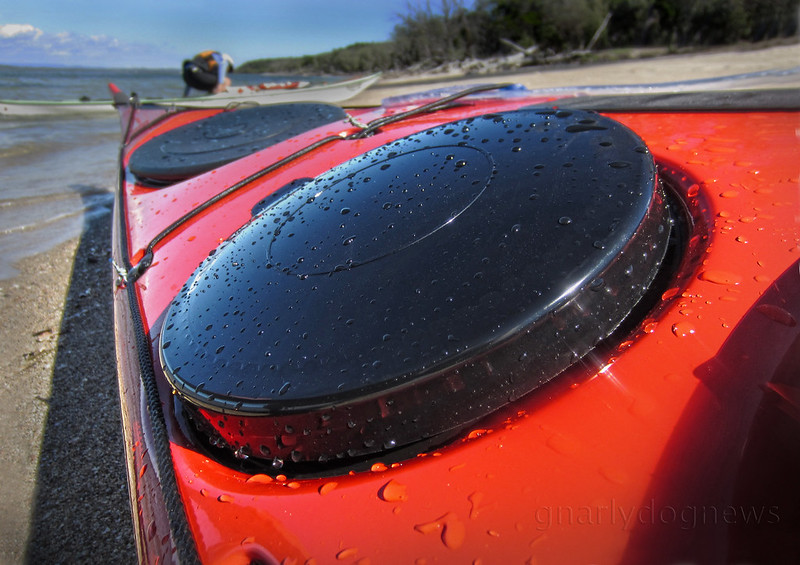
Sea-Lect day hatch cover: no edges to promote unintentional opening
Paddle Sport is the Australian importer for SEA-LECT Designs and Bruce offered me to test some samples. He sent me a day hatch and an oval hatch for my Valley kayak. The SEA-LECT covers are very different than the VCP ones, in material and design. Since I have previously had a bad experience with dual density hatch covers, where the inner hard plastic material would expand too much in the heat and become so loose to let water in, I was a bit concerned with the SEA-LECT one too. SEA-LECT Designs covers are also dual density material (injection molded polycarbonate and TPU material.) but the centre part is much stiffer and the lid shape is domed.

3 solid anchor for a lanyard
The underside of the dome has 3 hard plastic tabs where a lanyard can be attached to. Theses tabs are solid and won't get ripped out anytime soon, unlike the VCP ones.
The hatch cover is installed by depressing the dome firmly to make it expand on pop onto the rim. The action is extremely swift and positive.
Watch video below:
click to view video
The day hatch cover is too easy to install: center it and press down. Done!
It sits very tight on the rim and can not be dislodged unless pulled by the tab. No longer can the lid be popped open when doing a rescue since there are no edges to grab or catch. There is no longer the risk to flood the day hatch by inadvertently removing the hatch cover when you need it the least. The oval hatch cover needs a bit more pressure to pop onto the rim so dumping surf will not implode it. The biggest advantage on the SEA-LECT oval hatch is the thinner perimeter lip.

notice the clearance between hatch cover lip and deck recess
VCP hatch covers need to have the flange of the oval hatch pushed carefully into place or a tight seal is compromised. On some Valley (and other) kayaks I have noticed the black rim not aligned well to the deck recess making this sealing process really difficult. With a SEA-LECT oval hatch there is plenty of clearance and there is no need to follow the flange with your thumb and press into place.
This feature alone makes me want to replace all my hatch covers with SEA-LECT.
Beside the "slimming black", the covers also come in red, yellow or blue: perfect for the kayaker fashionista.
PS as promised to Steve G (see comments) here are a couple of images of detoriorated VCP day hatch covers
UPDATE 10DEC12
GDN reader Frank Baron from Florida, USA had a much more serious case of VCP hatch covers deterioration; his lids literally crumbled away...
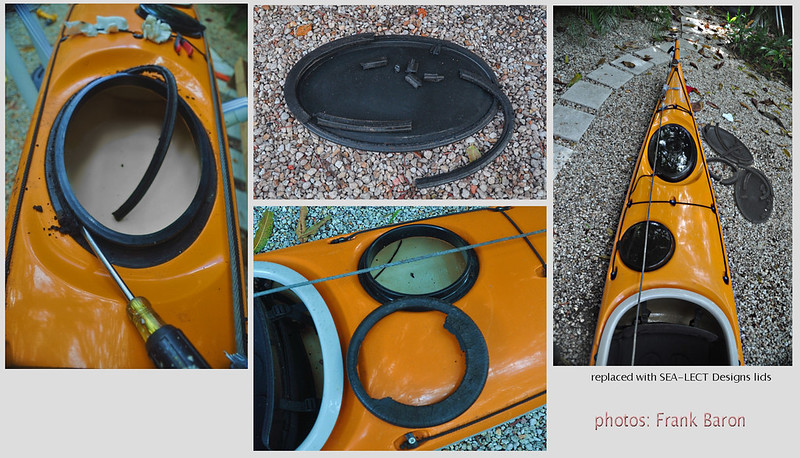
.
I regard sea kayaking a wet sport and getting wet is just part of the game.
Water inside the cockpit is often inevitable since I have not found yet a spray deck that really seals 100% (quality tuilik excepted). While I have leaned to live with a bit of water in the cockpit after rolling or heavy seas , I can not understand why so many kayaks have leaking hatches.
A hatch that leaks badly and takes on a gallon of water on a rough paddle it downright dangerous and should be immediately attended to and repaired. What bothers me also are the little leaks that occur in the hatches that apparently have a good hatch cover. I might be anal or OCD but I think there is no need to have sloppy workmanship or design to deliver a kayak with hatch covers that don’t seal well.
Recently one of my not so old kayaks (admittedly I buy new kayaks quite often) the day hatch started to leak. I swapped the cover with another kayak (same size lid) and reduced the leak but never really eliminated it. It annoys me to have wet gear in my hatches: why could not my spare clothing be dry when I need it? why do I have to keep everything in good dry bags to keep it safe? why do I have to wash with freshwater the hatches because they accumulate brine? There has to be a better way.
I managed to rectify the problem on my Zegul 520 with replacement rubber lids from Kajak-Sport (the dual density leaked badly in the heat) but it is also my Valley day hatch that leaks. Some of my paddling friends have noticed their VCP day hatch covers have started to deteriorate and crack; prompted by their concern I checked mine and I noticed the same: cracking of the foam-rubber. After hearing reports from so many kayakers that VCP covers had to be replaced too often and too soon I searched for alternatives. SEA-LECT Designs seems to be the only viable alternative to the factory replacement Valley hatch covers.

Sea-Lect day hatch cover: no edges to promote unintentional opening
Paddle Sport is the Australian importer for SEA-LECT Designs and Bruce offered me to test some samples. He sent me a day hatch and an oval hatch for my Valley kayak. The SEA-LECT covers are very different than the VCP ones, in material and design. Since I have previously had a bad experience with dual density hatch covers, where the inner hard plastic material would expand too much in the heat and become so loose to let water in, I was a bit concerned with the SEA-LECT one too. SEA-LECT Designs covers are also dual density material (injection molded polycarbonate and TPU material.) but the centre part is much stiffer and the lid shape is domed.

3 solid anchor for a lanyard
The underside of the dome has 3 hard plastic tabs where a lanyard can be attached to. Theses tabs are solid and won't get ripped out anytime soon, unlike the VCP ones.
The hatch cover is installed by depressing the dome firmly to make it expand on pop onto the rim. The action is extremely swift and positive.
Watch video below:
click to view video
The day hatch cover is too easy to install: center it and press down. Done!
It sits very tight on the rim and can not be dislodged unless pulled by the tab. No longer can the lid be popped open when doing a rescue since there are no edges to grab or catch. There is no longer the risk to flood the day hatch by inadvertently removing the hatch cover when you need it the least. The oval hatch cover needs a bit more pressure to pop onto the rim so dumping surf will not implode it. The biggest advantage on the SEA-LECT oval hatch is the thinner perimeter lip.

notice the clearance between hatch cover lip and deck recess
VCP hatch covers need to have the flange of the oval hatch pushed carefully into place or a tight seal is compromised. On some Valley (and other) kayaks I have noticed the black rim not aligned well to the deck recess making this sealing process really difficult. With a SEA-LECT oval hatch there is plenty of clearance and there is no need to follow the flange with your thumb and press into place.
This feature alone makes me want to replace all my hatch covers with SEA-LECT.
Beside the "slimming black", the covers also come in red, yellow or blue: perfect for the kayaker fashionista.
PS as promised to Steve G (see comments) here are a couple of images of detoriorated VCP day hatch covers

UPDATE 10DEC12
GDN reader Frank Baron from Florida, USA had a much more serious case of VCP hatch covers deterioration; his lids literally crumbled away...

.
tags
accessory,
British kayaks,
day hatch,
designs,
repair,
review,
safety,
sea kayak,
SEA-LECT Designs,
strong
01 June 2012
GEAR: the kayak sled by Hybrid
I busted my back lifting a kayak to my shoulders and carrying it to the beach.
X-rays revealed some spinal degeneration that apparently is caused by an accumulation of accidents.
The quack asked me: "Have you had any falls on your back in your past, even as a child?"
Me: "About one a year, if not more..."
The back injury is probably a manifestation of a life full of crashes on skis, motorcycles, mountain bikes and who knows what other back blows that I used to just shrug off when occurring. They are now catching up with me :-(
I am also sure that my current sedentary lifestyle (desk jockey) and lack of regular exercise during the week contribute to my now bad back. What bugs me is that I can't carry my kayak solo on my shoulders and look macho, even though I feel some of my kayaks are not exactly ultra light.
So, my back got bad again schlepping my boat across a bank of sand onto shore and into a back yard. Not a long distance but long enough to compress my spine out of whack; I need a trolley even for that short of a stretch.
The kayak carts I have are bulkier than I would like; they also have wheels.
Wheels and the shallow small lagoon I have to cross don't mix: the axle would clog up and the bearing would suffer.
I then remembered attending a presentation at a kayak fest (NSWSKC Rock&Roll in 2009) where a kayak designer showcased a "sled" that required no wheels.
Hybrid kayak sled presented at Rock&Roll 2009
I needed something like that.
I contacted Andre Janecki, the brilliant designer behind the Hybrid 550 sea kayak and founder of the Hybrid Foundation. Andre has been tinkering and inventing all his life; his expertise spans from architecture to industrial design, including his passion for sea kayaking.
Andre is also a philanthropist seeking funds for producing a sea kayak that will enable wheel-chair bound paddlers to access the water unassisted, in a kayak. (More info here)
I asked Andre for details on the "sled" and he immediately offered to help sending me a new sample that he showcased a few years back.
Here is the "Kayak Sled"
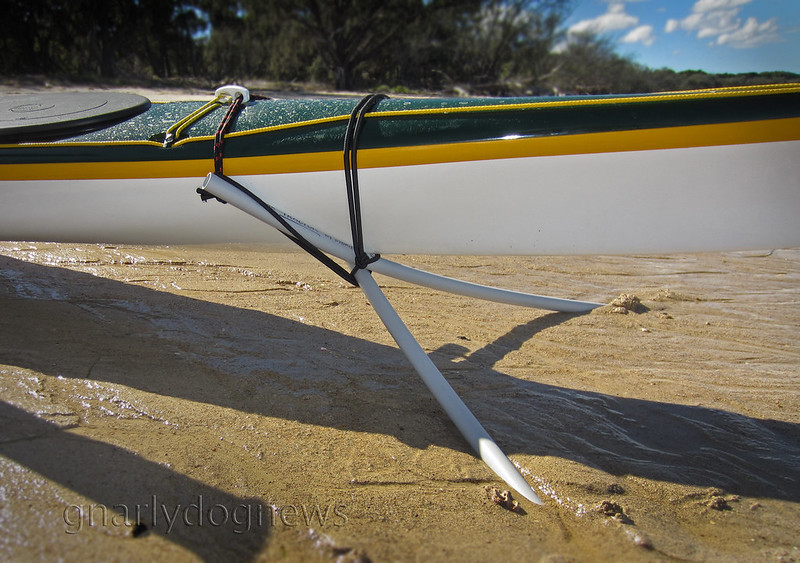
Mounted on the stern, the bungee cords are not essential to the operation of the sled
Simple in design the sled is a good alternative to wheels, providing it doesn't get dragged over pavement too much. I would like to quote A. Einstein: "Anything should be made as simple as possible, but not simpler"
It weights slightly more than a water bottle and takes almost no space inside the hatch, when folded.
It doesn't rust and costs so little to fabricate that even the kayaker on the tightest budget can afford.
Adventuretess testing the Hybrid Kayak Sled
While they are easy to replicate, Andre Janecki holds the copyright to the design. He is happy to share his invention with all paddlers who donate $25 into the Hybrid Foundation account.
Chasing up individuals that want to forego his request is not his intention but I am sure he would have a legal team onto a commercial operation trying to swipe his idea.
For exact dimensions and details, please email Andre Janecki and support his project.
Included are a few shots of the "Kayak Sled" showing general proportion as well as some details of the design.
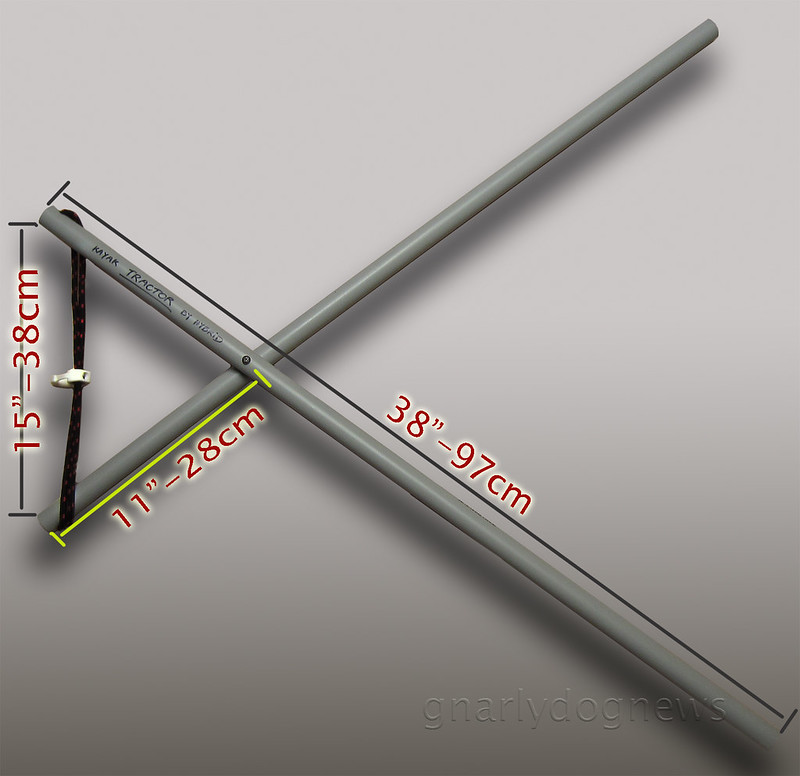
The double (or single) rope (shown with the white plastic hook) should be securely clipped to the deck fitting/s
The 316 Stainless Steel screw is 60mm long x 5mm thick and the nut is the nylon-lock type.
The PVC tubes are standard stock size 25mm O/D diameter, sourced from an electrical/plumbing supplier.

The Hybrid kayak sled folded
The 25mm tubes are further stiffened with the 20mm inner tubes. Please note: the inner tubes run top and across to approx. 2/3rd length only. This configuration assists with bending and distributing the load as much as possible.
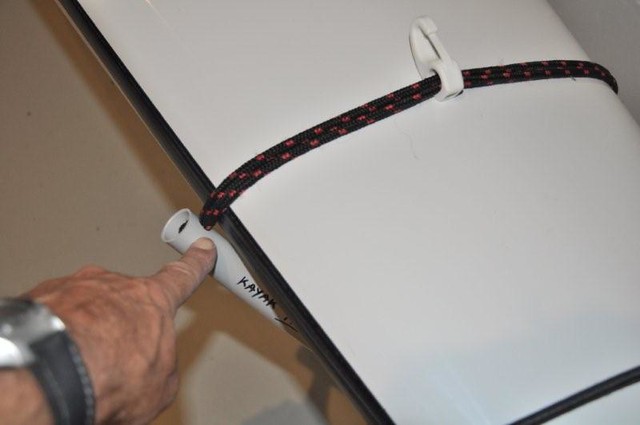
IMPORTANT: the cord exit point from the PVC tube should be against the hull
P.S. Of course, the cheap PVC tubes have only a very limited carry load capacity.
Andre informs me that the commercial version will use very different materials, including a custom made cross section, etc.
.
X-rays revealed some spinal degeneration that apparently is caused by an accumulation of accidents.
The quack asked me: "Have you had any falls on your back in your past, even as a child?"
Me: "About one a year, if not more..."
The back injury is probably a manifestation of a life full of crashes on skis, motorcycles, mountain bikes and who knows what other back blows that I used to just shrug off when occurring. They are now catching up with me :-(
I am also sure that my current sedentary lifestyle (desk jockey) and lack of regular exercise during the week contribute to my now bad back. What bugs me is that I can't carry my kayak solo on my shoulders and look macho, even though I feel some of my kayaks are not exactly ultra light.
So, my back got bad again schlepping my boat across a bank of sand onto shore and into a back yard. Not a long distance but long enough to compress my spine out of whack; I need a trolley even for that short of a stretch.
The kayak carts I have are bulkier than I would like; they also have wheels.
Wheels and the shallow small lagoon I have to cross don't mix: the axle would clog up and the bearing would suffer.
I then remembered attending a presentation at a kayak fest (NSWSKC Rock&Roll in 2009) where a kayak designer showcased a "sled" that required no wheels.
Hybrid kayak sled presented at Rock&Roll 2009
I needed something like that.
I contacted Andre Janecki, the brilliant designer behind the Hybrid 550 sea kayak and founder of the Hybrid Foundation. Andre has been tinkering and inventing all his life; his expertise spans from architecture to industrial design, including his passion for sea kayaking.
Andre is also a philanthropist seeking funds for producing a sea kayak that will enable wheel-chair bound paddlers to access the water unassisted, in a kayak. (More info here)
I asked Andre for details on the "sled" and he immediately offered to help sending me a new sample that he showcased a few years back.
Here is the "Kayak Sled"

Mounted on the stern, the bungee cords are not essential to the operation of the sled
Simple in design the sled is a good alternative to wheels, providing it doesn't get dragged over pavement too much. I would like to quote A. Einstein: "Anything should be made as simple as possible, but not simpler"
It weights slightly more than a water bottle and takes almost no space inside the hatch, when folded.
It doesn't rust and costs so little to fabricate that even the kayaker on the tightest budget can afford.
Adventuretess testing the Hybrid Kayak Sled
While they are easy to replicate, Andre Janecki holds the copyright to the design. He is happy to share his invention with all paddlers who donate $25 into the Hybrid Foundation account.
Chasing up individuals that want to forego his request is not his intention but I am sure he would have a legal team onto a commercial operation trying to swipe his idea.
For exact dimensions and details, please email Andre Janecki and support his project.
Included are a few shots of the "Kayak Sled" showing general proportion as well as some details of the design.

The double (or single) rope (shown with the white plastic hook) should be securely clipped to the deck fitting/s
The 316 Stainless Steel screw is 60mm long x 5mm thick and the nut is the nylon-lock type.
The PVC tubes are standard stock size 25mm O/D diameter, sourced from an electrical/plumbing supplier.

The Hybrid kayak sled folded
The 25mm tubes are further stiffened with the 20mm inner tubes. Please note: the inner tubes run top and across to approx. 2/3rd length only. This configuration assists with bending and distributing the load as much as possible.

IMPORTANT: the cord exit point from the PVC tube should be against the hull
P.S. Of course, the cheap PVC tubes have only a very limited carry load capacity.
Andre informs me that the commercial version will use very different materials, including a custom made cross section, etc.
.
tags
accessory,
carry straps,
DIY,
expedition,
gadget,
injury prevention,
invention,
lightweight,
review,
safety,
sea kayak,
simple
Subscribe to:
Comments (Atom)

.jpg)

